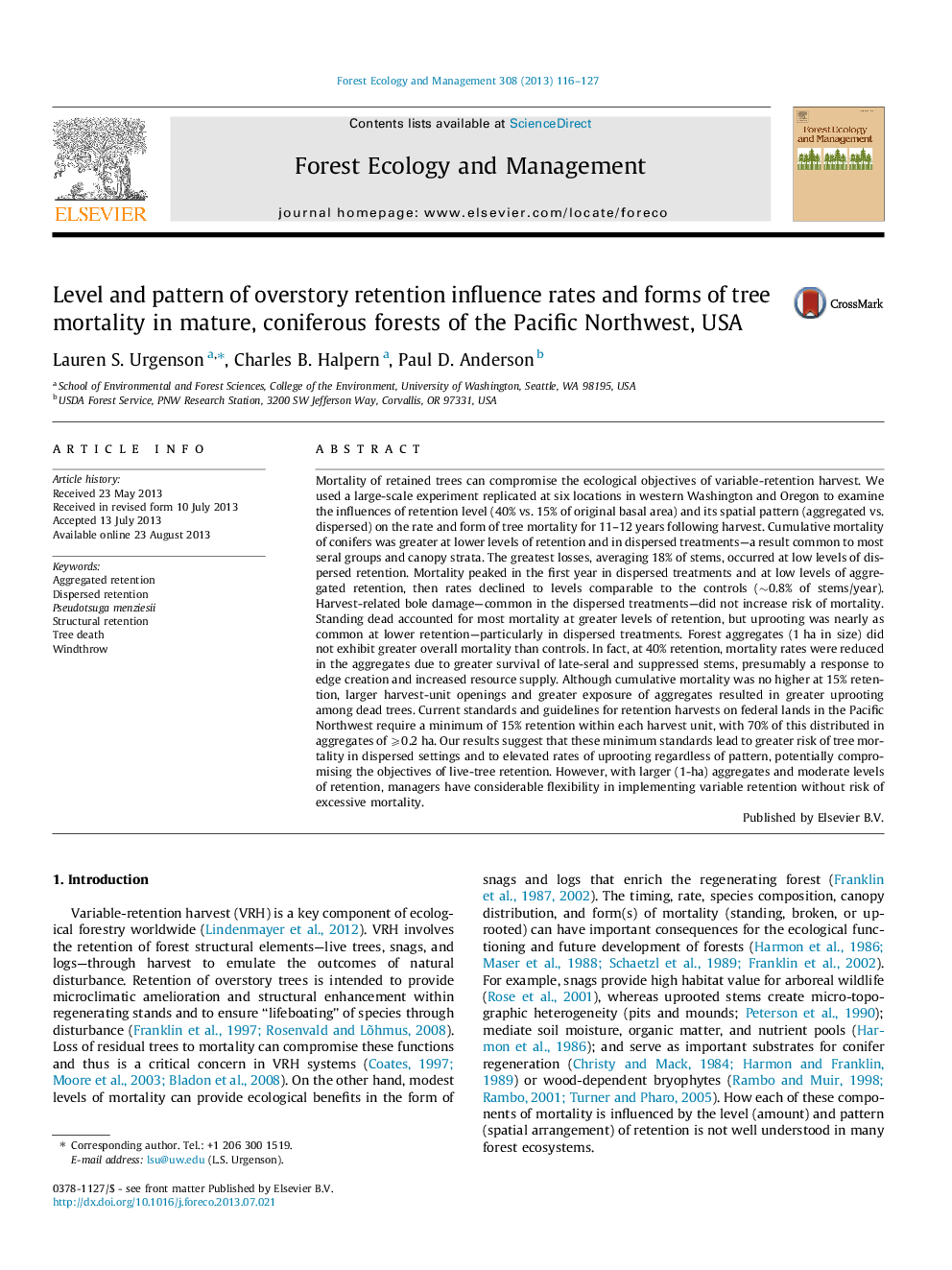| کد مقاله | کد نشریه | سال انتشار | مقاله انگلیسی | نسخه تمام متن |
|---|---|---|---|---|
| 6543954 | 159213 | 2013 | 12 صفحه PDF | دانلود رایگان |
عنوان انگلیسی مقاله ISI
Level and pattern of overstory retention influence rates and forms of tree mortality in mature, coniferous forests of the Pacific Northwest, USA
دانلود مقاله + سفارش ترجمه
دانلود مقاله ISI انگلیسی
رایگان برای ایرانیان
کلمات کلیدی
موضوعات مرتبط
علوم زیستی و بیوفناوری
علوم کشاورزی و بیولوژیک
بوم شناسی، تکامل، رفتار و سامانه شناسی
پیش نمایش صفحه اول مقاله

چکیده انگلیسی
Mortality of retained trees can compromise the ecological objectives of variable-retention harvest. We used a large-scale experiment replicated at six locations in western Washington and Oregon to examine the influences of retention level (40% vs. 15% of original basal area) and its spatial pattern (aggregated vs. dispersed) on the rate and form of tree mortality for 11-12 years following harvest. Cumulative mortality of conifers was greater at lower levels of retention and in dispersed treatments-a result common to most seral groups and canopy strata. The greatest losses, averaging 18% of stems, occurred at low levels of dispersed retention. Mortality peaked in the first year in dispersed treatments and at low levels of aggregated retention, then rates declined to levels comparable to the controls (â¼0.8% of stems/year). Harvest-related bole damage-common in the dispersed treatments-did not increase risk of mortality. Standing dead accounted for most mortality at greater levels of retention, but uprooting was nearly as common at lower retention-particularly in dispersed treatments. Forest aggregates (1 ha in size) did not exhibit greater overall mortality than controls. In fact, at 40% retention, mortality rates were reduced in the aggregates due to greater survival of late-seral and suppressed stems, presumably a response to edge creation and increased resource supply. Although cumulative mortality was no higher at 15% retention, larger harvest-unit openings and greater exposure of aggregates resulted in greater uprooting among dead trees. Current standards and guidelines for retention harvests on federal lands in the Pacific Northwest require a minimum of 15% retention within each harvest unit, with 70% of this distributed in aggregates of ⩾0.2 ha. Our results suggest that these minimum standards lead to greater risk of tree mortality in dispersed settings and to elevated rates of uprooting regardless of pattern, potentially compromising the objectives of live-tree retention. However, with larger (1-ha) aggregates and moderate levels of retention, managers have considerable flexibility in implementing variable retention without risk of excessive mortality.
ناشر
Database: Elsevier - ScienceDirect (ساینس دایرکت)
Journal: Forest Ecology and Management - Volume 308, 15 November 2013, Pages 116-127
Journal: Forest Ecology and Management - Volume 308, 15 November 2013, Pages 116-127
نویسندگان
Lauren S. Urgenson, Charles B. Halpern, Paul D. Anderson,